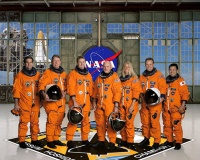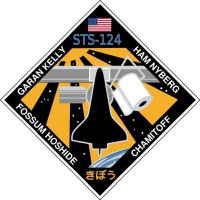STS-124
From The Space Library
 | |
| Organization | NASA-Office of Space Flight (United States) |
|---|---|
| Mission type | Human Crew,Resupply/Refurbishment/Repair |
| Launch date | May 31, 2008 |
| Launch vehicle | Space Shuttle |
| Launch site | Cape Canaveral, United States |
| COSPAR ID | 2008-027A |
| Inclination | 51.6 degrees |
| Experiments | Here |
| Alternate Names | 32960 |
| Additional Information | Here |
| Data Collection | Here |
| Payload Mass Up | 15408.07 kg |
| Payload Mass Down | 766.82 kg |
| Orbiter | Discovery |
| Lift Off Mass | 2,056,856.36 kg |
| Orbiter Weight at Liftoff | 122,328.64 kg |
| Orbiter Weight at Landing | 92,418.18 kg |
| Landed | 11:15 a.m. EDT, concrete runway 15, Kennedy Space Center, Fla. |
| Orbits of Earth | 217 |
| Orbital Altitude | Approximately 185 nautical miles |
Contents |
[edit] Crew
- Commander: Mark E. Kelly
- Pilot: Kenneth T. Ham
- Payload Commander:
- Mission Specialist 1: Karen L. Nyberg
- Mission Specialist 2: Ronald J. Garan
- Mission Specialist 3: Michael E. Fossum
- Mission Specialist 4: Akihiko Hoshide, Japan Aerospace Exploration Agency (JAXA)
- Mission Specialist 5:
- Payload Specialist 1:
- Payload Specialist 2:
ISS/Mir Crew Transport
- Gregory E. Chamitoff - up only Garrett E. Reisman - down only
[edit] Mission
STS 124 is an American shuttle craft that was launched towards the International Space Station (ISS) at 21:02 UT on 31 May 2008. It carried seven astronauts (six American, and one Japanese) to the ISS. The major mission is to install the 16-tonne pressurized, second segment of the Japanese research laboratory, and to repair the liquid toilet. It was to dock with the ISS on 02 June. Three spacewalks are planned for the installation and integration of the lab. The shuttle will land back after a 14 day mission. During the launch, foam debris from the external fuel tank was observed to hit the launch pad. An inspection by the crew later found no visible impact on the shuttle itself. Supplemental information on the mission will be reported in July issue of this Bulletin.
[edit] EVA
Extravehicular Activity (EVA) conducted by Mike Fossum and Ron Garan during three spacewalks for a total of 20 hours, 32 minutes. EVA 1, 6 hours, 48 minutes; Fossum and Garan prepared the Kibo JEM-PM for installation on the ISS by disconnecting cables and removing covers while Kibo was still in the shuttle's payload bay. They also assisted with the transfer of the Orbiter Boom Sensor System (OBSS) back to the shuttle from the station, where it had been stored since the last shuttle visit. EVA 2, 7 hours, 11 minutes; Fossum and Garan focused on external outfitting of the new module, including installing cameras that will help monitor external robotic and payload operations. EVA 3, 6 hours, 33 minutes; Fossum and Garan replaced a nitrogen tank assembly (NTA) on the station's starboard truss. After they detached the empty NTA, Garan rode the fully extended Canadarm2 from the tank's installation area to External Storage Platform-3, where it was stored until its return on the STS-126 mission.
[edit] Payload
ISS Assembly Flight 1J; Japanese Experiment Module - Pressurized Module (JEM-PM) and Japanese Remote Manipulator System; crew exchange
[edit] Books about the Space Shuttle Program
Buy This Book Click here |
Buy This Book here |
Buy This Book Click here |
Buy This Book Click here |





